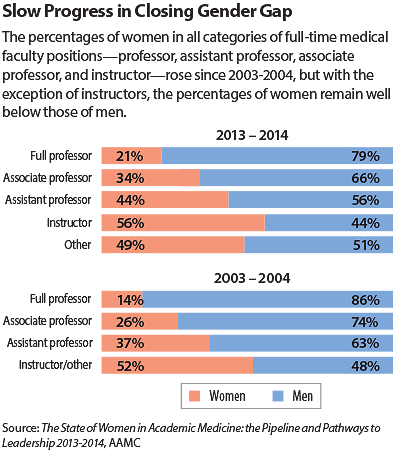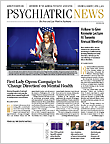Women continue to make progress in academic medicine but remain underrepresented at key career stages, according to a report from the Association of American Medical Colleges (AAMC).
Despite modest progress in some areas, including an increase in the number of women entering medical school and in the percentage of women in faculty positions, women continue to be underrepresented among senior faculty, department chairs, and medical school deans, according to the report, “The State of Women in Academic Medicine: The Pipeline and Pathways to Leadership.” The percentage of women leaving faculty positions also rose, however.
The report draws on data from the AAMC’s 2013-2014 survey on Women in Medicine and Science (WIMS) as well as 2014 data from the AAMC Faculty Roster.
“Within academic medicine, medical school deans, department chairs, associate deans, and faculty and staff in a range of leadership positions have opportunities to think innovatively about transforming systems of training, discovery, and health care delivery that keep academic medical centers (AMCs) at the forefront of improving patient care and health in the United States,” according to the report. “If women choose to leave the academic medicine workforce, their departures may contribute to a decrease in the diversity and talent of the workforce and may ultimately limit organizational success. Conversely, if AMCs can promote equity through sound institutional practices, they can increasingly retain the talented doctors, scientists, and administrators who are so vital to achieving their missions.”
When the WIMS survey was administered in May 2014, 129 medical schools were fully accredited by the Liaison Committee on Medical Education. Of these, 117 responded. Here are some findings from the survey:
•
Students and residents: Although the number of women applying to medical school (48,014) has increased since the last report in 2008-2009, their proportion of the applicant pool, at 46 percent, has decreased.
•
Faculty workforce: Women make up a little more than a third (38 percent) of the full-time academic medicine faculty (see chart above for a breakdown by position). New hires of women faculty are up 4 percent, but departures are up 5 percent.
•
Leadership positions: There has been an increase in the number of women who are chairs and deans of medical school departments, but the percentage remains low at 15 percent and 16 percent, respectively. The percentage of women assistant professors has remained stable at 46 percent.
Psychiatry ranked sixth among specialties for the number of women residents in 2013-2014, behind internal medicine, pediatrics, family medicine, internal medicine specialties, and OB-GYN. But psychiatry ranked third among departments with the highest proportion of women in faculty positions, behind internal medicine and pediatrics.
As for the students and residents, the report noted that the percentage of women residents has remained relatively flat since 2008-2009, when women accounted for 45 percent of residents. “Further, while women increasingly are entering specialties where they have been historically underrepresented, such as surgery, large gender disparities still exist,” the report stated. “These data point to a need for focused research on individual career decisions of women students after their training.”
With regard to faculty workforce, the AAMC noted that the proportion of full-time faculty who are women has risen only 2 percent since its 2009-2010 Women in Medicine and Science Benchmarking Report. “In looking particularly at how women are represented among higher academic ranks, the proportion of women continues to be lower when compared to male counterparts as the prestige of the position increases. ... Similar to women entering residency positions, full-time women faculty comprise far less of the proportion of faculty in specific departments such as surgery and radiology. Additionally, since 2008-2009, the percentage of promotions to associate professor or full professor who were women has risen only slightly, and the proportion of new tenures who were women has remained the same (38 percent).”
Finally, the increase in women in leadership positions is encouraging, but the sharp disparities in academic medicine can be seen across all stages of the pipeline from residency application to leadership, according to the report. “As women progress through their careers, they are less represented in positions with decision-making and leadership responsibilities,” the report emphasized. “Research is needed to explore how underrepresentation and pace of advancement for women in academic medicine may influence career choice.” ■
“The State of Women in Academic Medicine: The Pipeline and Pathways to Leadership, 2013-2014” can be accessed
here.

